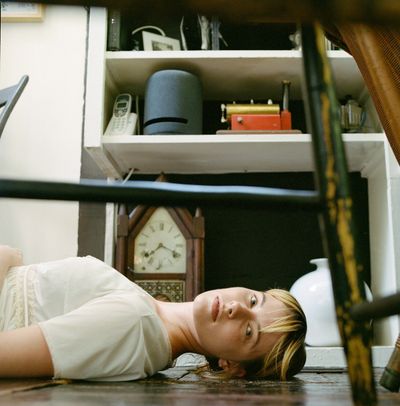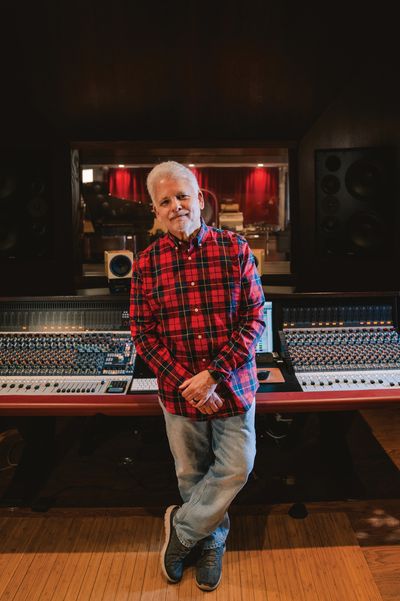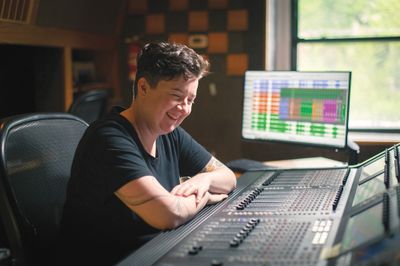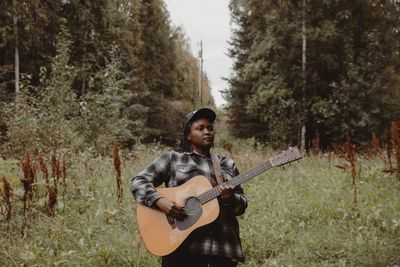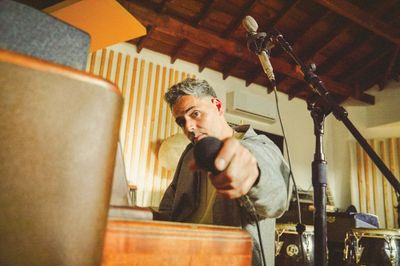Do you own this house?
Yeah, I've owned this house for ten years. I started out renting it because there was a space in the back that I could put a small studio in.
So when you were looking for houses, you were looking for a bigger space that you could set up a studio in.
Yeah.
What happened to the old basement? Do you just use it as storage now?
There's a jackfield on the wall in the main room and I separated the old room into two rooms so there's two feeds to two separate speaker rooms. I have a Marshall cabinet and I'm going to get a little Sun [bass] cabinet, a 4-speaker one which sounds great. Those go down there and that's my isolation. It's not beautiful, but for basic tracks I tend to close-mic those instruments anyway.
How did you build the big room?
I was going to build one big room in there and I talked to an acoustics guy and he gave me the absolute longest length given my width and height that I could work in for the least amount of standing waves. I went with his acoustics idea. I found out that if you're not building a really multi-sided room, to stay with a pretty strict rectangular shape. The reason being is, and I didn't know this, that if you create a very limited frequency standing wave, that it's a lot easier to handle and deal with then if you tilt a wall slightly and create a band of standing waves in a certain frequency area. So let's say you've got a standing wave that's sitting at 100 Hz and then you cock your long wall a couple of degrees then all of a sudden you have a multitude of standing waves from 90-110 Hz. So I did that and I talked to RPG and their idea was absorption on the walls and diffusion on the ceiling, which I wasn't into. It seemed like I would waste my time doing a large room and then kill the reflections on the walls because we don't hear things that way. I'm not killing them because I did the opposite thing-some hanging panels on the ceiling to break up the ceiling-to-floor reflections and diffusion on both of the long walls. You've heard it — it's a very live room. You can hear it on [Clutch's] "Jam Room" really.
The wood helps.
The drum sound is huge and the wood helps. I used Hudson Industries' floating floor system which is the same one they used when they redid the Kennedy Center so the floor is completely floating.
On little rubber pucks?
Yeah. And the floor is pushed up against the foam against the walls so the walls don't touch the floor. The ceiling is a grid hung down from the real ceiling so that the ceiling isn't connected to the ceiling joists. It was kind of labor intensive.
Did you do most of it yourself?
I didn't do any of it myself. What I did myself was I went out and did lots of audio/video installations and worked really hard and paid carpenters a third of what I was making to be good carpenters. I'm kind of a perfectionist and I'm also ADD, so those two combinations work really badly together. It means that I try to do things too quickly, I screw them up and complain about them later. The cool thing is that when someone else makes a mistake, you don't really notice it.
And you can complain about it.
You can complain and make them fix it. I contracted it myself, I did most of the design with the guy and I found people for $20/hr to do the work.
And how long did it all take? Soup to nuts?
A year.
What would you have if you had an unlimited amount of money to spend on gear?
I would combine Pro Tools with... a... Neve, no, I might prefer an API...
I like API.
It's a little snappier than Neve and it's nice... API combined with having the Pro Tools right there to do editing and I guess a 2" tape machine with Dolby SR. I think the funny thing is that when people think of 2" recording, they think of a Studer and a Neve console. When they think of ADATs they think of an ADAT and a Mackie board with a couple of Alesis compressors or something and so they're not really hearing what can be achieved.
So you would go to 2"? You'd do 2" and then transfer it into Pro Tools...?
Well, or keep it on the 2" and use Pro Tools to move stuff around. I would have that ability. I might keep my ADATs and mix and match. You can almost have a 2" 16-track and just track the drums and bass to it and then call it a day. I like digital vocals and guitars better.
You like recording distorted guitars with digital?
Guitars and drums are what I like analog for.
For the bass too?
Bass, I can go either way, it depends.
Because it gets a little more snap. For the kind of money you're talking about, the new Sony board is 56-inputs, touch-fader automation, 4-band EQ where the top and bottom can be shelves or filters or bells, and dynamics on every channel, and it's $17,000.
It's true.
It's just going to be a matter of making sure that there are processors that emulate some of the things that we've liked before. I mean, no one's rushing off to do online editing anymore. Avid's got the fidelity-it's there. C'mon, I don't want to be a dinosaur.
There are actually people who are really adamant about analog tape and now it doesn't make as much sense to be wary of the technology. Digital has gotten to a point where it works and sounds decent.
The same people were screaming about samplers...It's amazing — I saw some interview show where Tom Petty and all these old guys were talking about how much they hate samplers and new technology. Aren't they going to look back...? They're like "parents" age and they're talking the way that their parents talked about their music.
Well, we're all afraid of a lot of new technology, too much, too fast, to a certain degree. In terms of financing, don't you think, "Oh, I'm gonna buy something and then it's going to be obsolete."
Yeah, that's one point of view. I'm also talking about the people who are afraid of the technology because 20 rap groups abuse a sampler and make records that are like, one loop. Then everyone says the sampler is bad. That's the same as one guy playing guitar feedback for an hour and that proves to you that the guitar and amplifier are bad. [laughter] It's funny when I read the articles. I had an [Tascam] MS-16 when Clutch first came here and then I got the 16- bit ADATs. I thought that the ADATs sounded like CDs which isn't exactly what I want but the 16-track sounded like cassette tape which I didn't want either and that was with dbx noise reduction which I hate.
But you said before that you don't like hiss... you had to use something.
I don't like hiss. It was a 15 ips machine and you had a choice of DBX or not and you could put it on each individual channel. I may have picked and choosed a little bit. But I don't like hiss, do you like hiss?
I like it as an effect — it depends on the song. If the song is really moody and really dry and it has a lot of open space, then I like it. It's the same reason that I like vinyl noise. I like a lot of records because there's that extra something in there that kind of fills out any of the space that makes you feel like... empty. My parents lived in this house once where when you walked in, there was this huge living room with really high ceilings that opened into the dining and the whole place was wood floors and sheetrock walls, no carpets or area rugs. You walk in and say "Hey" and it just felt so weird because of all the wacky reverberation and it was really creepy feeling. I get the same empty, creepy feeling without hiss or vinyl noise sometimes.
I kinda like that. I like the big dynamic range -I like the absence of noise when there's nothing that's playing.
Again, it depends. Dynamic range is definitely importnat with some music, like classical.... or PJ Harvey...
I think Avail has done two or three records since they did their second and third records with me and we did those on ADATs and all these people were talking about Avail and how they loved the "big analog sound" that we were getting and the same thing with [Clutch's] "Jam Room". I don't think the Sixty-Watt [Shaman] sounds immediately like "oh, that's a digital recording". I'm using these Valvotronic micpres. There's a guy in New Jersey that Jason [Corsaro] turned me onto and he had someone set up the transformers for him and they're his own design of tube stuff. It's that Valvotronic compressor that I have and I have 4 channels of API [3124].
What are your big monitors?
I'm using the Westlake BBSM-10s. I've had those for a long time. It's funny cause I went to a trade show and I asked the guys, "When do I need to replace the drivers?" and they said if they're not blown, they're fine. And those are the guys that own the company.
I noticed you have a little something set up next to the board.
I use NHTs. I do audio/video installation and it's a little home speaker that I got used to and I think they sound really good. I've never liked [Yamaha] NS-10s, they're too brittle for me, so I like to have a home speaker and I can listen on a home speaker cause a lot of people listen to home speakers in their home. And they're cheap, they're about $350.
And you have speakers in the bathroom...
Well, I have speakers all over this house... there's speakers in the bathroom, the kitchen, the dining room... There are 13 pairs of actual speakers in this house because I'm a home stereo installer.
What other gear do you have?
We talked about the new Valvotronic mic pres I got and the APIs that I have and then I have a couple of the old Ampex MX-10 mixers, the ones with the big knobs. I'm using those as mic pres but I think I'm going to wire them up so that I can mix stuff down to one.
Do you have a mono speaker setup?
I just push the mono button on the board. I'm using the Yamaha 02-R and Pro Tools for mixing but I'm thinking of moving to the Sony.
How many software versions have you had to go through with the 02-R?
Just two.
Did you notice a lot of fixes?
A lot of things were taken care of. I think it's really amazing. I think it's great. I think that you want to use good mics and good mic pres and good compressors and a lot of analog gear but I think that as time goes on mixing and storage will become digital. If a lot of people are recording to 2" tape and then bouncing to Pro Tools to mix, then someone's going to come up with an algorithm that comes close enough to that sound... I have Magneto [Spectral Design], it's cheap, a couple hundred bucks. The funny thing about it is that it's an algorithm of a $2800 box that's a digital in/digital out box.
Since we're on that subject... do I like digital? I hate DATs! And I hate CDs! Everything should be 24- bit. You want to keep the resolution as high as possible. What do you mix to?
I mix through my Apogee PSX-100 converter and it bit- splits out to an ADAT, so it's 16 bits on the first channel, 8 bits on the next channel, 16 bits then 8.
How do you recombine it?
Right back through the converter. You mixdown sending it to the Apogee as your final analog- to-digital converter and it bit-splits out and it puts it on [the ADAT].
So, tracks 1 & 2 and tracks 3 & 4?
Yeah, and then when you playback through the Apogee converter, you just push the digital passthrough button and it reconverts that back into a 24-bit AES output. So my Pro Tools is usually tied up because I'mmixingwithitandalotoftimesit's48KsoI go analog-out from my tube bus compressor, through the Apogee, digital-to-analog conversion and then analog-to-digital conversion... gets me to 44.1, which gets me to the ADAT. When I went to master the Sixty-Watt [Shaman] record up in New York, I just put the whole thing back into Pro Tools and brought the Pro Tools files and for the first time I went to mastering with CDs, which were 24-bit files on CD. They're relatively low error count. I feel more comfortable with them than DATs, don't you?
Oh, yeah, definitely with audio files.
A lot of people are using the Tascam 24-bit double speed DATs.
Which version of Pro Tools did you start with?
I started with Sound Designer. I had Pro Tools 16- bit NuBus, I had Pro Tools 2, Pro Tools 3... I've been working my way up. They're a little bit of a jerky company but they're really good about their upgrade path. They'll always say, "Well, send this back, give us another coupla grand and you're back." Some companies say, "You just bought that at the wrong time..." You use Pro Tools 24? How do you get in and out of it?
Just with one 888 or I rent one or two more depending on the record. Do you ever rent anything?
Rarely. If I like something I buy it. I spend a lot of money on gear.
You're investing.
When I bought my mastering compressor, a friend of mine asked how much it would increase my business and I had to explain to him that I don't really think about it that way. It's not about increasing my business — it's about my increasing happiness with my product and whether my clients can hear the difference. I can hear the difference. It seems that people are more open to digital technology. What do you mix to?
Sometimes I go to DAT or sometimes I go into another 2 channels in Pro Tools. That's my way of cheating without using automation so it's locked up with the Pro Tools tracks and I can just stop, go back, adjust the mix and then punch in. I'm really anal about renaming files, so I get rid of the fragments and then I make a continuous file out of the whole song or whatever.
And you bought your own hard drive?
Yeah, I bought an 18 gig drive.
Aren't you nervous about carrying it around? About dropping it?
I'm not even thinking about that! I'm thinking about magnets and current. If I ride the bus, I don't sit on certain seats in the back or on the subway, I don't sit at all or if I'm in a car, I keep the drive in my lap!
How much magnetism does it take...?
I don't know but I'm paranoid about it.
